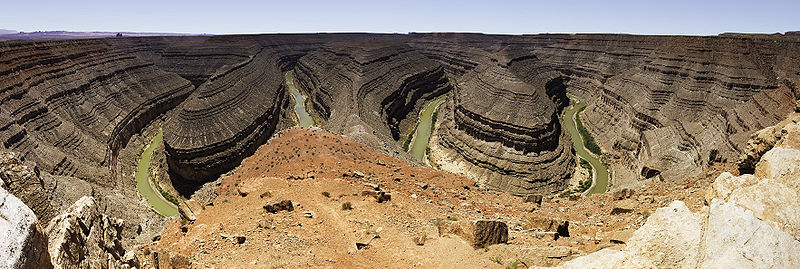Did those experiments use a small amount of water to cut deep, nearly vertical trenches in sandstone, limestone, granite and bedrock?
I think you have flume experiments wrong. See all flume experiments usually do is show how large amounts of water cut very fast, not small amounts of water. I believe it was John Morris who stated something like "a lot of water a little time, or a little water a lot of time." However in flume experiments this is not the case, a little water does nothing in flume experiments. You see it's not the water cutting the canyons it's the aggregate/rocks/sand that are floating in the water. Water itself is relatively soft. Don't get me wrong, pure water under pressure (key word) can cut, but abrasive water is by far the prevailent erosional fluid. More info:
Abrasive Waterjet Cutting | Abrasive Cutting for Hard Materials: Flow Waterjet
And the gully was cut through ash and mud, not limestone, sandstone, granite and bedrock.
limestone, sandstone, granite, and bedrock are all soft with the exception of granite possibly.
There are lots of canyons through bedrock that happened fast. Same with sandstone. Even the coconin sandstones layers in the grand canyon has evidence of a huge body of water depositing these vast sheets quickly.
"Evidence of Rapid Deposition
The buff-colored Coconino Sandstone
is very distinctive in the walls of
Grand Canyon. It has an average thickness
of 315 feet (96 m) and covers an
area of at least 200,000 square miles
(518,000 km2) eastward across adjoining
states.4 So the volume of sand in
the Coconino Sandstone layer is at
least 10,000 cubic miles (41,682 km3).
This layer also contains physical
features called cross beds. While the
overall layer of sandstone is horizontal,
these cross beds are clearly visible as
sloped beds (Figure 6). These beds are
remnants of the sand waves produced
by the water currents that deposited
the sand (like sand dunes, but underwater)
(Figure 7). So it can be demonstrated
that water, flowing at 3–5 miles
per hour (4.8–8 km/h), deposited the
Coconino Sandstone as massive sheets
of sand, with sand waves up to 60 feet
(18 m) high.5 At this rate, the whole
Coconino Sandstone layer (all 10,000
cubic miles of sand) would have been
deposited in just a few days!
Ayers Rock (or Uluru) in central
Australia consists of coarse-grained
sandstone beds that are almost vertical,
tilted at about 80° (Figure 8). The total
thickness of these sandstone beds,
outcropping in Ayers Rock and found
under the surrounding desert sands, is
18,000–20,000 feet (5,500–6,100 m).6
The minerals in the sand grains are distinctive,
and the closest source of them
is at least 63 miles (101 km) away.
Under the microscope the sand
grains appear jagged and are of different
sizes (Figure 9). One of the
minerals is called feldspar, and it appears
to be still unusually fresh in the
sandstone. These features imply rapid
transport and deposition of all this
sand, before the feldspar grains could
disintegrate or the sand grains could
be worn down into round pebbles or
sorted by size.7
So soup-like slurries of sediment,
known as turbidity currents, which
travel at speeds of up to 70 miles per
hour (113 km/h), must have transported
all this sand, 18,000–20,000 feet
thick, a distance of at least 63 miles
and deposited it as the Uluru Sandstone
beds in a matter of hours! This
defies evolution ideology but fits with
the Creation/Flood history of Genesis."
from:
http://www.answersingenesis.org/contents/379/am/v3/n3/flood_evidence_3.pdf
They don't. Plugging Steve Austin and Grand Canyon into Google Scholar doesn't produce any hits. Writing an article consistent with the ICR's statement of faith and having it appear in one of their publications is not peer review.
[/QUOTE]
the peer review was done by the USGS early 80's, author steve austin- called "little grand canyon"
I am sure it's not popular enough to be rated high on googles pay per click advertising schemes. (I like DuckDuckGo, search...but it is still a little young and needs work, Google has been corrupted from the simplicity of it's early days).
I will look for it when I have time.


